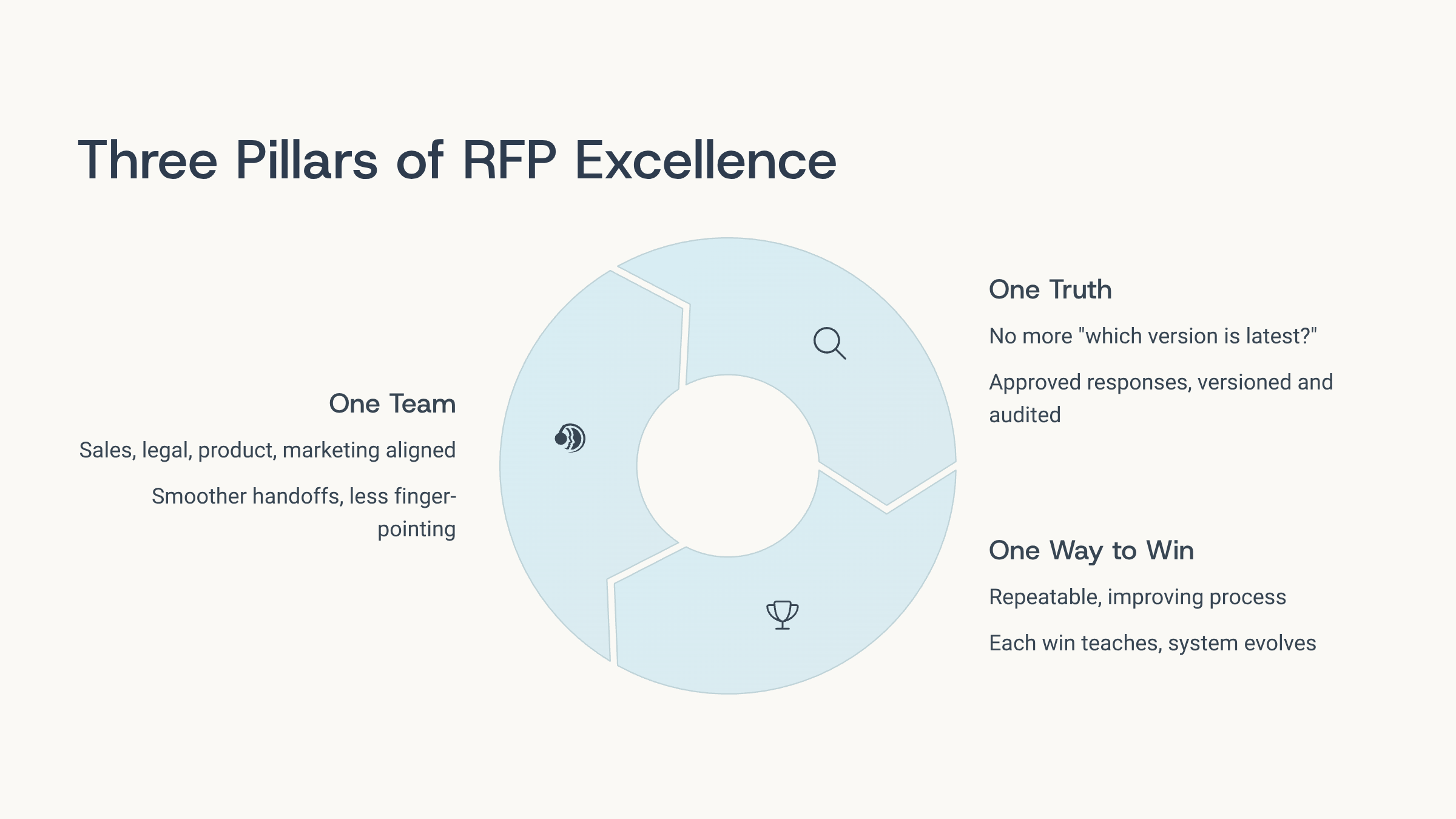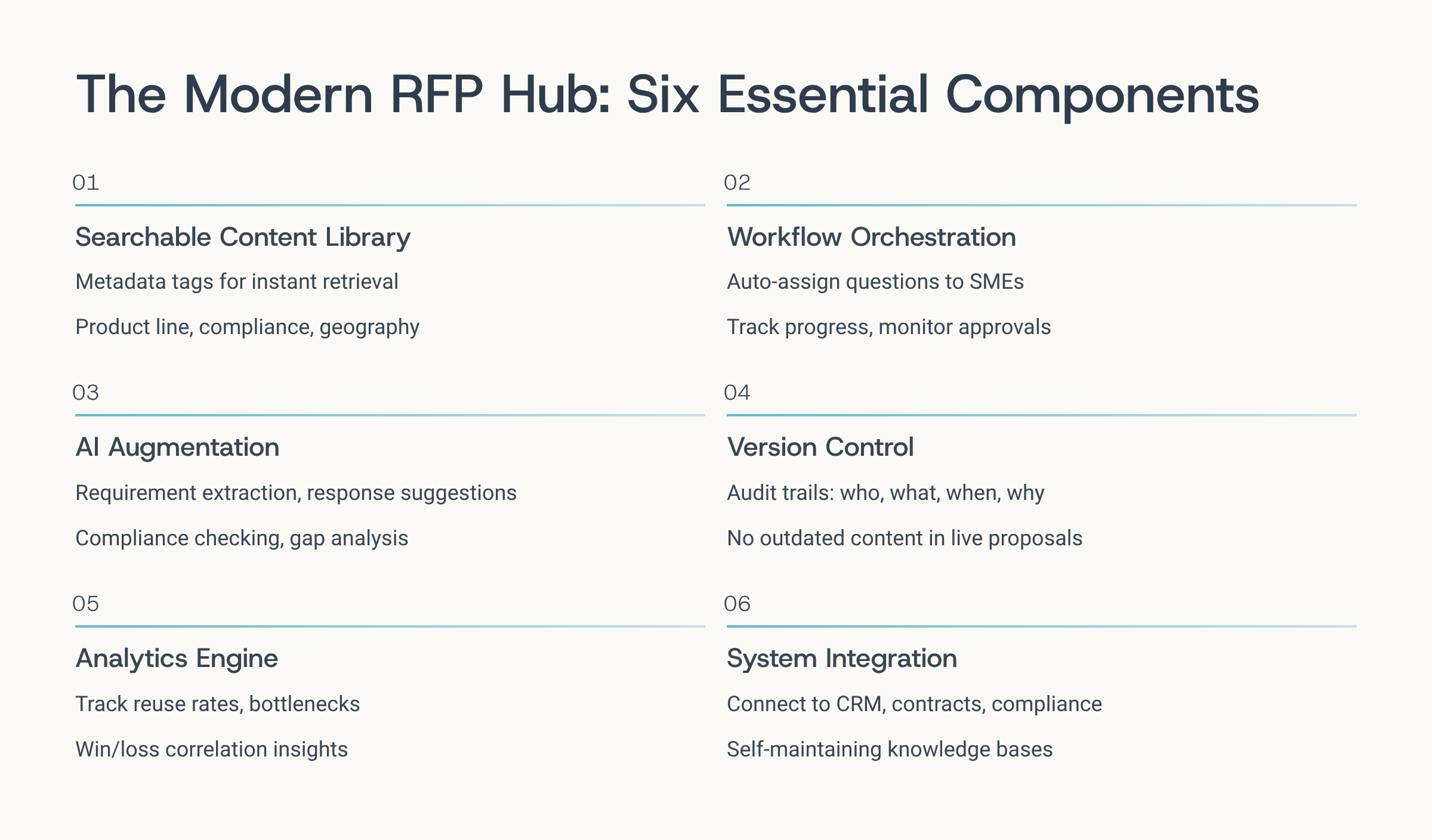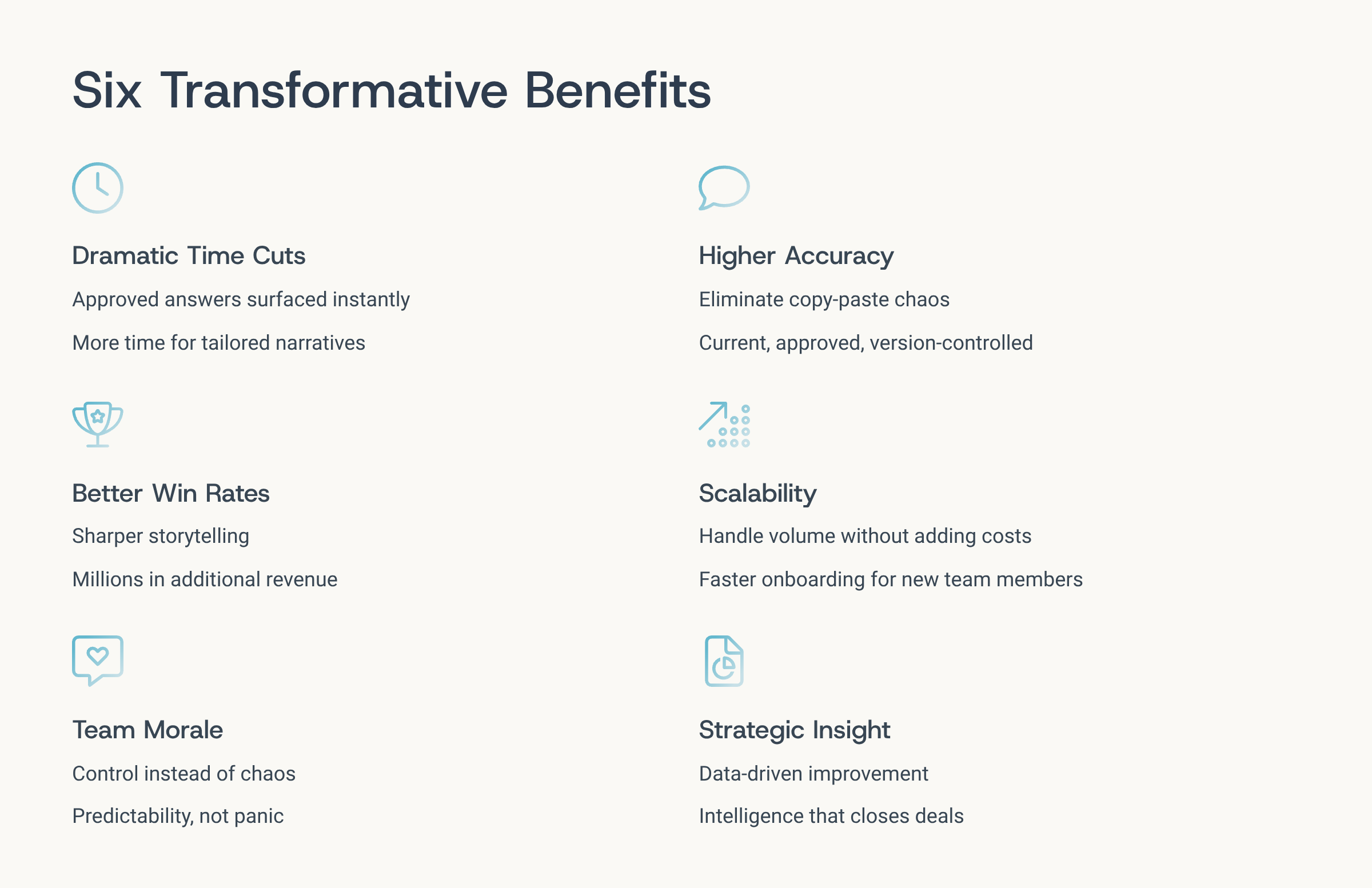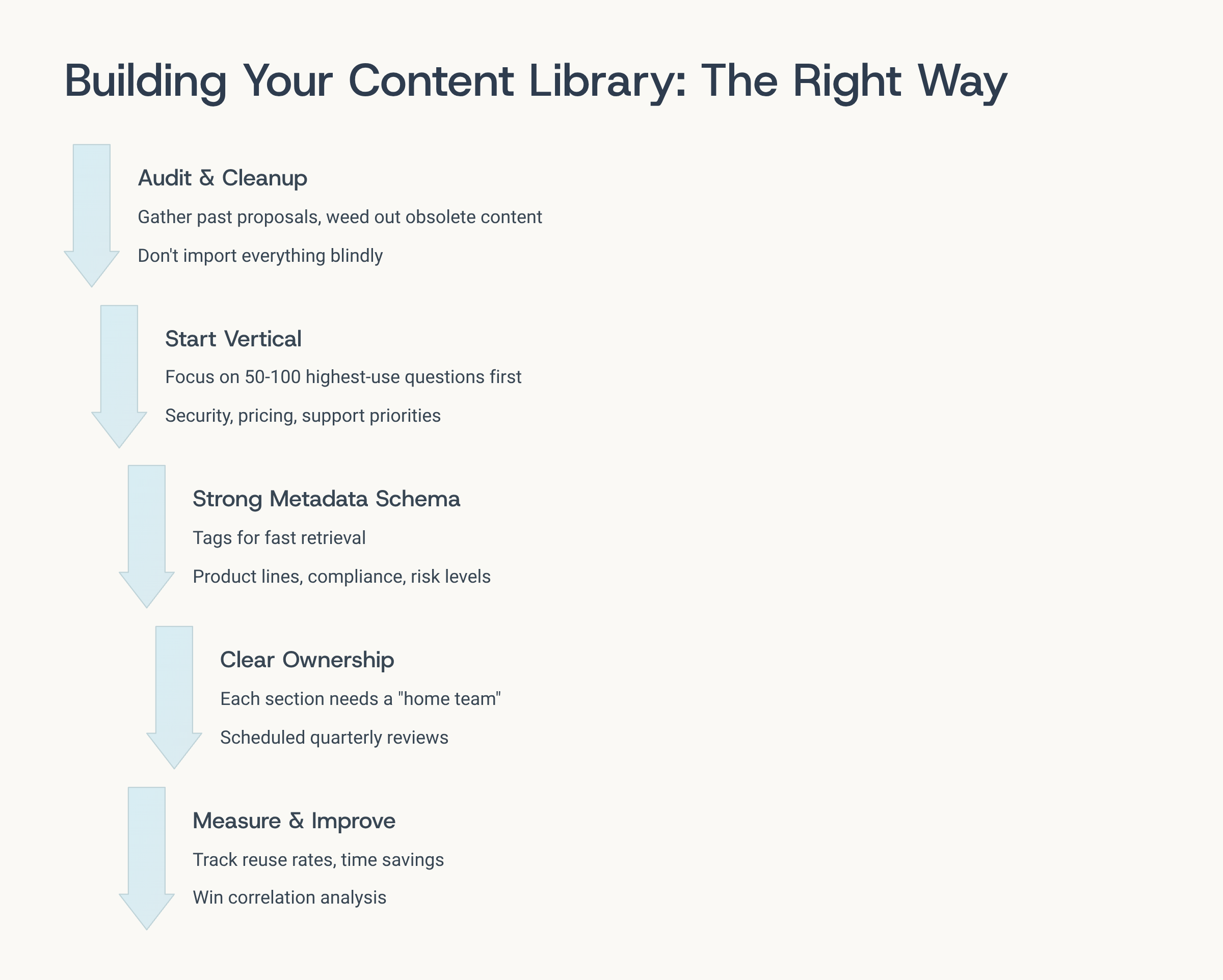Centralized RFP Content: One Team, One Truth, One Way to Win
Article written by
Kate Williams

INSIDE THE ARTICLE
SHARE THIS ARTICLE
Summary
Disorganized RFP content is silently killing deals. Inconsistent answers, outdated documents, and scattered ownership erode trust, slow down responses, and damage your brand. This post breaks down the hidden costs of decentralization, shows how centralizing your RFP content improves speed and win rates, and gives you a 90-day roadmap to build a single source of truth that scales.
How many times have you thought, ‘If I have to copy-paste this answer one more time, I’m quitting sales and opening a coffee shop’?
I have seen it all. The RFP drops, and instead of sharpening strategy, you’re chasing old versions across Slack threads, SharePoint folders, and someone’s ‘final_final_v3.docx.’ The outcome? Brilliant teams losing to just better-organized competitors. Let’s talk about why that happens—and how centralizing RFP content flips the script from chaos to confidence.
The Real Cost of Fragmented RFP Content
You already know how this plays out: someone sends an RFP, and you see a treadmill. Re-searching, chasing teammates, reconciling conflicting answers. What’s rarely measured is the hidden cost.
Most of the software sales teams already use some form of centralized response system. Without centralization, teams waste more than half of their first draft effort just copying and pasting from old repositories—time that should be spent customizing responses or shaping a smarter win strategy.
The impact goes deeper:
Opportunity Cost
Hours spent redrafting or searching are hours not spent customizing the proposal or going after another opportunity.
Risk of Inconsistency
Inconsistencies (quoting different features, outdated data, mismatched branding) erode credibility. Buyers see them.
Compliance and Audit Danger
In regulated industries, a misquoted clause or outdated compliance statement is not just embarrassing—it’s disqualifying.
Burnout and Team Fatigue
Proposal teams routinely report stress and burnout. Proposal teams without a centralized content library are the teams that regularly work overtime and have high stress levels.
When the system is broken, every deal is a struggle. But that brokenness is what centralization is meant to solve.
Why Centralization Now Is Non-Negotiable
Over the past few years, two forces have reshaped the RFP landscape: buyers expect more, and teams are pressured to deliver with less. On one side, prospects demand crisp, confident, and polished proposals. On the other, proposal teams are stretched thin, juggling tight timelines and competing priorities.
Centralization is what bridges that gap. A single hub of approved content gives buyers the reliability they’re looking for and gives teams the speed they desperately need. The numbers back it up: organizations with centralized RFP content report faster response times and stronger win rates because they’re not reinventing answers from scratch. Even a modest 5% boost in win rates can translate into a 5% lift in annual RFP-driven revenue—a meaningful edge in enterprise sales.
Three Pillars: One Team. One Truth. One Way to Win.
So what does “centralization” actually look like in practice? It’s more than just moving files into a single drive. True centralization is a cultural and operational shift—one that transforms how sales, legal, product, and marketing work together.
At its core, centralization rests on three non-negotiable pillars:
One Team
When sales, legal, product, and marketing contribute to a shared content backbone, oversight and handoffs get smoother. You reduce finger-pointing and redundancy.
One Truth
No more “which version is latest?” debates. Approved responses, compliance clauses, case studies—they all live in one place, versioned and audited.
One Way to Win
Instead of improvising for each RFP, you build a repeatable, improving process. Each win teaches something, and the system evolves.
These pillars form the foundation of what some call “proposal operations”, treating RFPs as an operational system that improves over time. Also, AI/automation is pushing this need into the mainstream. According to recent industry forecasts, centralized RFP content plus intelligent systems can halve response time and double proposal accuracy.

What a Centralized RFP Hub Really Looks Like
A “central hub” isn't a file server. It’s a living, interconnected system. Let’s break down what works now and what’s emerging:
1. Searchable, structured content library
Every answer, clause, case study, and spec lives with metadata (tags: product line, compliance, geography, version, and date). That makes retrieval fast and reliable.
2. Collaboration & workflow orchestration
Assign questions to SMEs automatically, track progress, set reminders, and monitor approvals. No more emailing files back and forth.
3. AI/Automation/NLP augmentation
These capabilities are not pipe dreams—they're already rolling into many proposal platforms.
- Parsing & requirement extraction: AI reads the RFP document, extracts the key asks, and maps them to existing content so human teams don't have to start from zero.
- *Response suggestions/drafting:* The system proposes draft content based on matching answers or partially filled content, which SMEs then refine.
- Compliance & gap checking: The system flags missing elements (e.g. missing SLA in compliance-heavy RFPs) or version mismatches.
4. Versioning + Audit Trails
You need to know who changed what, when, and why. Old versions can’t bleed into live proposals.
5. Analytics & feedback loops
Track metrics like how many questions were answered from the library vs. new writing, which sections took the longest, reuse rates, and win/loss correlations. Use that data to improve the library, refine templates, and close gaps.
6. Integration & architecture
The centralized hub should connect to CRM, contract systems, content management, and possibly external compliance systems. The more integrated, the less friction.
As this architecture becomes more common, we are also seeing self-maintaining knowledge bases, where AI helps prune stale content, auto-tag new entries, or alert owners when content ages.

6 Benefits of a Centralized RFP Content Library
When centralization and automation are more than buzzwords—when they’re executed with discipline—the payoff is transformative. Here’s what organizations see once they make the shift:
1. Time Cuts
In a fragmented system, teams waste hours just finding and rewriting content. With a centralized hub, approved answers are surfaced instantly. That means:
- Turnaround times shrink almost by half on average.
- Cycle time reduces when AI-driven templates are layered in. The outcome? More time for sales teams to actually tailor proposals, strengthen narratives, and engage buyers—activities that directly influence win rates.
2. Higher Accuracy & Fewer Errors
Copy-paste chaos breeds mistakes: outdated features, inconsistent pricing, or mismatched compliance clauses. A centralized library eliminates these risks by ensuring every piece of content is current, approved, and version-controlled.
- No more embarrassing contradictions inside the same proposal.
- No more outdated case studies making their way into enterprise bids. For regulated industries especially, this shift from “probably right” to consistently accurate is the difference between staying in the race or being disqualified.
3. Better Win Rates
Time saved and accuracy gained both fuel a larger outcome: higher win rates. When your team isn’t scrambling for answers, they have space to:
- Customize content for the buyer’s unique context
- Highlight differentiators with confidence
- Craft an executive summary that resonates at the decision-making level This sharper storytelling often translates into higher win rates—a seemingly small improvement that compounds into millions in annual RFP-driven revenue for SaaS enterprises.
4. Scalability
Growth creates a paradox: more RFPs mean more opportunities—but also more workload. Without centralization, the only way to handle increased volume is by adding headcount or burning out your SMEs. With a centralized library, however, you can scale output without scaling costs.
- Proposals can be generated in parallel with less SME involvement.
- New team members onboard faster because content is easy to find and reuse. This elasticity lets you pursue more deals without breaking your team.
5. Team Morale
Behind every RFP win is a team that had to grind for it. But constant late nights, last-minute requests, and redundant tasks drain morale. Over time, burnout leads to turnover—a hidden cost few leaders factor in. Centralization flips that equation:
- Teams feel in control, not in chaos.
- SMEs aren’t bombarded with repetitive questions.
- Proposal managers have predictability, not panic. The shift may sound “soft,” but happier, less-stressed teams consistently perform better—and stick around longer.
6. Strategic Insight
This is the benefit most overlooked: data-driven improvement. Centralized systems don’t just store answers; they generate intelligence. With the right analytics, you can see:
- Which answers are reused most often
- Which sections correlate with wins (or losses)
- Where bottlenecks slow down progress Armed with these insights, you’re not just responding to RFPs—you’re constantly improving how you respond. That means more predictable outcomes and smarter investments in the content that actually closes deals.

How to Build a Content Library That Actually Delivers
Getting this right isn’t plug-and-play. Many fail because they focus on the tool first, not the foundation. Here’s how to do it better:
Begin with audit & cleanup
Gather past proposals. Weed out obsolete content. Identify “good to use” vs “needs overhaul.” Don’t import everything blindly.
Go vertical, not horizontal—start with most common replies
Pick your 50–100 highest-use or highest-risk question areas (e.g., security, pricing, support). Nail those first. Expand gradually.
Strong metadata & tagging schema
Use tags for product lines, geography, compliance regimes, last update date, owner, and risk level. Good metadata = fast retrieval.
Clear ownership & refresh cycles
Each section needs a “home team” (legal, product, compliance) that owns updates. Schedule reviews (quarterly or semiannual).
Template & guidance layer
Don’t just store flat answer text. Build templates (e.g., for executive summary and technical response) and style guides (tone, grammar, and the “Is-Does-Means” method).
Incentivize reuse and feedback
Track reuse rates. If answers aren’t reused, ask why. Use feedback from wins and losses to evolve the library.
Integrate & automate updates
If your RFP hub can connect to external systems (product database, contract management, compliance registry), auto-sync critical data to reduce manual drift.
Train & socialize usage
Just because you build a library doesn’t mean people will use it. Train teams, set expectations, and surface the value quickly (e.g., “This answer is already approved and saves you 30 minutes”).
Measure impact
Metrics like reuse rate, time per question, error rate, and win correlation must be visible. Use those to guide improvements.
These steps reduce waste, build trust in the system, and ensure adoption.

Turning Process Into Advantage
Think of having two proposals side by side. Same RFP, same deadline.
- Team Fragmented exhausts hours chasing content, reworking sections, and squabbling over which version. They deliver just in time, but it feels stitched together.
- Team Centralized spins off approved answers quickly, leaving time to tailor narrative, emphasize differentiators, and weave in insights and client context.
The second one feels confident. It feels intentional. That difference matters to a client.
Today, centralization doesn’t just avoid mistakes—it gives you room to compete with clarity and focus.
When the process frees people, people elevate the proposal beyond checkboxes.
Conclusion
Centralized RFP content isn’t a future experiment. It’s already moving from “nice to have” to mandatory for any enterprise serious about scaling proposals. Across sectors, teams combining a solid content backbone, intelligent workflows, and AI augmentation are raising the bar—not just for output, but for quality and sustainability. Also, with sales enablement tools like SparrowGenie, the entire process gets easier than ever before.
Ready to see how AI can transform your RFP process?
Product Marketing Manager at SurveySparrow
A writer by heart, and a marketer by trade with a passion to excel! I strive by the motto "Something New, Everyday"
Related Articles

Who Are Forward Deployed Engineers and Why AI Teams Can't Ship Without Them

Revenue Execution Platform: 101 Guide
